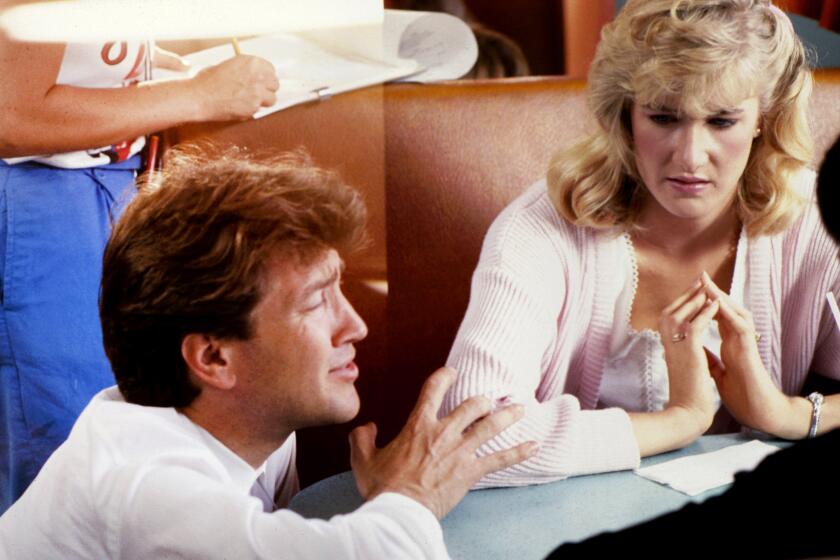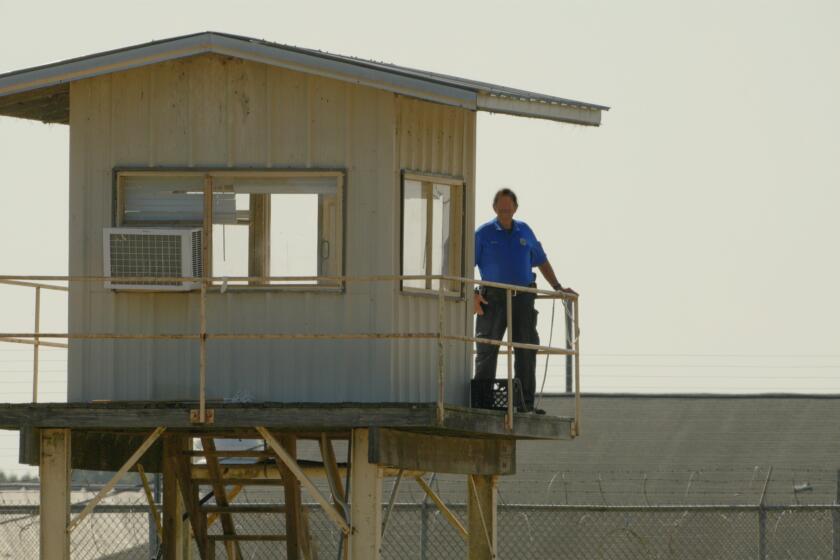Travel Guy’d : The road to acclaim for ‘Ocean Tribe’ was a trip. OCC graduate Will Geiger of Seal Beach made the male-bonding surf movie.
- Share via
The only temperamental actor on the set was the film’s aging star: a 30-year-old ambulance with a psychedelic paint job and a broken transmission.
This star has no lines but is nonetheless essential to the story. After all, what is a road picture without a car?
Besides, the 1966 Oldsmobile ambulance is more recognizable than the five unknown lead actors in Will Geiger’s award-winning movie “Ocean Tribe,” a male camaraderie picture in which the ambulance serves as surf wagon for five beach-bound buddies, one of whom is terminally ill.
The story, although fictional, was inspired by Balboa Island resident Bob Cook, who died in 1991. After chemotherapy for cancer caused Cook to lose his hair, his buddies who worked with him on the Balboa Ferry shaved their heads in a show of support.
“When I heard that story, I called and asked if I could interview them,” Geiger said. “I spent the day with Bob Cook, who was a very special and strong person.”
Geiger, a Seal Beach resident and recent graduate of the film-video department of Orange Coast College in Costa Mesa, wrote, directed and produced the 102-minute film.
When “Ocean Tribe” had its world premiere in April at the Los Angeles Independent Film Festival, it beat more than 1,000 other entries to earn Geiger, 34, a prestigious directing award and a $2,500 prize from the Director’s Guild of America.
That quickly got Geiger a six-figure advance for foreign distribution rights. Negotiations for a domestic deal could net the fledgling filmmaker even more. Plus there’s talk of an offer for Geiger to direct a film for a Hollywood studio.
That places Geiger at the foot of a path taken by such writer-directors as Steven Soderbergh (“sex, lies, and videotape”) and Kevin Smith (“Clerks,” “Chasing Amy”), who parlayed inexpensive, self-financed features into assignments for multimillion-dollar productions.
“Will is an incredibly talented filmmaker who has offered us an extraordinary first film,” said Robert Faust, founder and director of the L.A. film festival. “We were proud to be able to debut it.”
The festival is well-attended by members of the Hollywood film industry, and Faust said that several previous winners have been acquired by major studios.
Chuck Warn, a DGA spokesman, said the guild’s policy is not to offer critical assessments of such films. But he said that the directing award Geiger received indicated how important independent films are to the DGA.
“Independent films are really the life’s blood of the future of Hollywood filmmaking,” he said.
Geiger’s shot “Ocean Tribe” in 24 days in September on location in Huntington Beach, Mexico, Florida and Northern California. Friends reunite seven years after high school to take a terminally ill pal on one final surfing trip to Mexico.
It received favorable reviews from Filmmaker magazine, the Hollywood Reporter and Variety, which called it a “visually striking feature debut . . . uplifting and exhilarating.”
Geiger said his phone has not stopped ringing.
“I was getting calls from agents and studio people because the news had gotten out,” he said. “The Hollywood Reporter review came out the next day. So my phone went crazy for a week. I ended up doing a lot of lunches.”
Those lunches led to a deal with J&M; Entertainment, a leading international film distributor that has bought foreign distribution rights.
“We hope to place it in each and every territory,” said J&M; vice president Karen Roberts. “We have gotten a lot of interest from Asia and Australia.”
While arranging the domestic release of “Ocean Tribe,” Geiger continues to screen it at film festivals across the country. Next up is the Seattle International Film Festival, which runs Thursday through June 8.
Because so many Orange County friends are interested in seeing it, Geiger said he’s also trying to set up a local benefit screening.
Not bad for a former Bolsa Chica park ranger who a year ago couldn’t get Hollywood executives to return his calls--or got a brusque “forget it” from those who did.
After all, Geiger was a first-time director; his actors were unknowns, and he was breaking the cardinal rule of independent filmmaking by working on location. Not only that--he would be shooting scenes on the water, which can be risky even for a major studio with a big budget.
*
Yet Geiger planned to do it on a low six-figure budget that would barely buy lodging and food for the crew of most Hollywood productions.
“Nobody wanted to chance trying to make this kind of film with a director his first time out,” said Geiger, who also studied at UC Irvine and spent a year at London’s Royal Academy of the Dramatic Arts. “They thought there were too many things that could go wrong.”
Geiger and associate producer Andrew Matosich formed Sea Reel Productions. After raising about half of the minimum he had hoped for, Geiger began making the movie.
Although he would not say exactly how much it cost to make, he said it was well under $1 million--quite an accomplishment for a movie that includes underwater scenes with dolphins and original surfing footage, complete with 25-foot swells.
“Most producers we talked to said we’d need $1 million to $2 million to make the film,” he said.
Geiger, a film buff since he was a kid, believed it could be done for much less. After all, he had learned a lot about filmmaking, beginning as an aspiring actor at 18.
After landing a few bit parts, he changed his mind about acting and began studying writing and photography. In 1990, he got a job as an assistant director on a film in Rome, where he lived for two years and where he met his Italian-born wife, Antonia.
“I have worked in film in various forms for a long time,” he said, “and I got the idea of making my own movie while I was in Rome.”
He returned to Orange County, where he’s lived since he was a teenager, to learn how to do it.
“I went to Orange Coast College in ’93 and ‘94, and it was really that experience that solidified this and gave me a broad knowledge of how everything fits together.”
While at OCC, he made a music video that won a best cinematographer award at the college’s annual student film festival. (This year’s film festival is Friday.) He also won an award for a short film. And it was at OCC that he completed the script for “Ocean Tribe.”
“Will was an outstanding student,” said Bill Hall, chairman of the OCC film department. “He was extremely focused and serious about his craft. He’s on the verge of making it big.”
Geiger, whose father worked for the FBI, is at work on a script about an FBI agent, as seen through the eyes of an adolescent.
He hopes to have a bigger budget next time.
“On ‘Ocean Tribe’ all the actors worked for minimum wage,” Geiger said. “I only made enough to cover my living expenses, and the crew didn’t get paid hardly anything.”
*
When it came time to travel down the rugged Baja coast to shoot the Mexico sequence, Geiger asked his actors if they’d be willing to camp on the beach. They agreed, but when they arrived in the tiny village south of Ensenada, they found a 12-room motel, which they rented, and they rented two rooms in back of the Catholic church. Most of the 25 or so actors and crew members had beds to sleep in. The others stayed in a motor home.
“It was pretty remote,” Geiger said. “There were only two phones in town. One was in the one and only store; the other was privately owned.”
Geiger also discovered that paved roads in Baja are practically nonexistent. The crew’s cars suffered 14 flat tires from the jagged rocks on the tough, dirt roads. By then the movie’s dilapidated star was having transmission problems and had to be towed.
But it was worth the effort, Geiger said.
“I always liked the image of them going down in an ambulance,” he said. “I wanted to give them a good funky car if it was a road trip.”
*
Geiger wrote his story so that Bob, the terminally ill character, uses a wheelchair. In one scene, Bob, gleeful and exuberant, is perched in his wheelchair, atop the car, as it cruises along a deserted Baja road.
“This friend of mine is paralyzed, but he surfs on a belly board, and when he travels he straps his wheelchair to the top of the car, along with the surfboards,” Geiger said. “That image is one I always wanted to use in a film.”
The most difficult scenes involved surfing, Geiger said. “We could not afford to go to Hawaii. That’s where most surfing sequences are shot and where the big waves are.”
Instead, Geiger and his crew finished shooting and waited in Orange County, keeping a close watch on the weather. “We were waiting for a swell to come up. And suddenly I get this call from Jeff Neu, our surf and water cinematographer. He had been tracking this huge storm, and he said it would be here in a couple of days,” Geiger said. “We went like maniacs trying to get ready.”
Geiger and his crew again headed to Baja. “We had waves up to 25 feet; this was the most intimidating thing about making the film,” he said.
The Hollywood Reporter praised the film’s “breathtaking surfing cinematography.” And Movieline called it “beautifully produced and directed with sensational surfing photography.”
Geiger admits that he wasn’t fully prepared for such acclaim. And he credits OCC with helping him get it. “I’ve been bragging about OCC’s program whenever anyone asks me what film school I went to,” Geiger said.
His advice for aspiring filmmakers?
“The biggest mistake is to try and make a feature when you have never made one before,” he said. “Independent filmmaking has just exploded, and everyone thinks they can make one. But you have to have knowledge about how the whole filmmaking process works.”
More to Read
Only good movies
Get the Indie Focus newsletter, Mark Olsen's weekly guide to the world of cinema.
You may occasionally receive promotional content from the Los Angeles Times.










